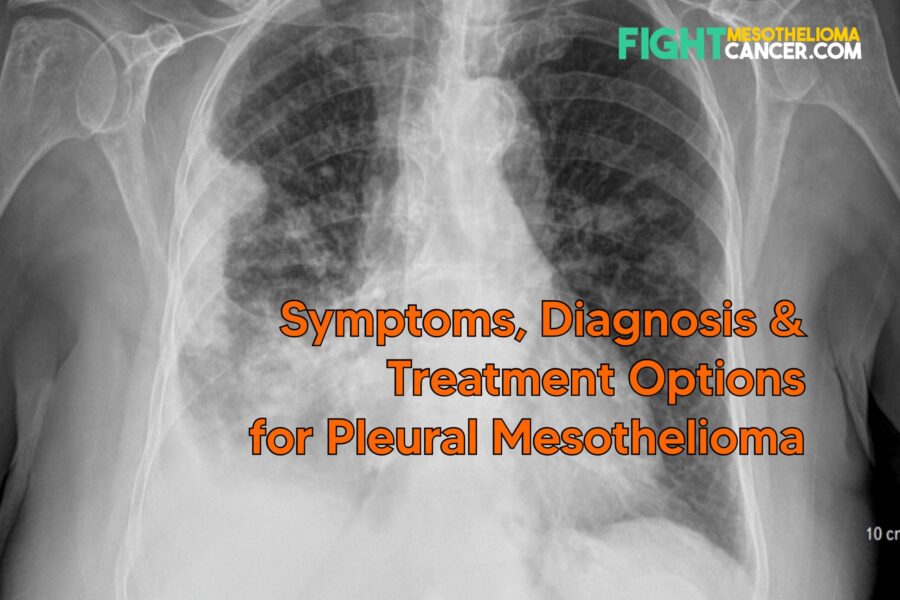About 2000 – 4000 Americans are diagnosed with Malignant Mesothelioma each year, and about 66% of those cases are of Pleural Mesothelioma.
Pleural Mesothelioma occurs when cancer hits the lining of the lungs, also known as the ‘Pleura.’ The Pleura is a Sac which houses the lungs, and consists of a thin membrane called the ‘mesothelium.’
The mesothelium is a vital part of the lungs because it enables them to expand and contract when breathing by secreting a fluid.
This fluid is located in the lungs and inside of the rib cage. If the Pleura or the Pleural fluid becomes damaged with Cancer, it makes it very hard for the patient to breathe, thus shortness of breath is a common symptom of Pleural mesothelioma.
Types of Pleural Mesothelioma
1. Benign Pleural Mesothelioma
A Benign pleural mesothelioma is NON-Cancerous, meaning it has not spread to other parts of the body. It the masses of tumor are large, it may squeeze the lungs making it hard for the patient to breathe & cause pain.
2. Malignant Pleural Mesothelioma
Malignant Pleural Mesothelioma is cancerous and can spread to other organs of the body. It commonly resides in the pleural sac lining of the lungs and is caused by exposure to Asbestos. More on malignant pleural mesothelioma follows below.
How Does Pleural Mesothelioma Develop?
When a person is exposed to Asbestos through job related duties or in a particular environment setting, inhalation of asbestos fibers that are loose in the air can occur.
These fibers can then make their way into the lung linings, outside of the lungs and inside of the ribs. To your left is an image of how Pleural Mesothelioma develops.
Asbestos fibers are normally located between parietal pleura (which lines the chest wall & diaphragm) and visceral pleura (which lines the lungs).
When asbestos fibers settle in the pleura, they cause inflammation which can in turn lead to development of malignant cancer. Some patients develop Asbestos first, then develop malignant mesothelioma (more on this below).
Multiple tumor masses can then develop affecting both the visceral and parietal pleuras. Since the parietal pleura is located nearest to the right lung (which is larger than the left lung), it suffers more damage than the visceral pleura located near the smaller left lung.
What’s also interesting is that more asbestos fibers settle in the lower lungs than the upper lungs. These tumor masses can grow fairly quickly and cover entire lung cavities.
When this happens, the patient feels distorting pain & shortness of breath. Also, if pleural mesothelioma develops into advanced stages, it can spread to nearby organs such as the heart, lymph nodes and abdomen.
Symptoms of Pleural Mesothelioma
Symptoms of Pleural mesothelioma can easily match symptoms of other common diseases such as pneumonia, extreme cough, flu or cold, therefore it is very difficult to diagnose pleural mesothelioma via the symptoms alone.
Because pleural mesothelioma takes between 30 – 50 years to develop after initial asbestos exposure, it often takes months for doctors to accurately diagnose it.
Not many patients know about asbestos exposure, neither does the doctor when you give your medical history. Thus this makes it very difficult to diagnose pleural mesothelioma.
Here are the common symptoms of pleural mesothelioma:
- Blood Clots
- Soarness
- Difficulty speaking
- Pleural Effusions (Fluid around the lungs)
- Excessive coughing
- Chest pain
- Difficulty in swallowing
- Formation of lumps under the skin on the chest
- Night sweating
- Fatigue
Since growing tumor masses enlarge the pleural space and fill it with fluids, this causes chest pain, which is easily mistaken for heart disease. The aftermaths of these symptoms include loss of appetite and excessive weight loss.
Treatment & Diagnosis of Pleural Mesothelioma
Advanced diagnosis techniques such as Magnetic Resonance Imaging (MRI), X-Rays or Computed Tomography (CT) scans as well as Biopsy are used to accurately diagnose pleural mesothelioma.
Biopsy samples the tissues and fluids around the lungs and looks for asbestos particles that may reside in the tissues.
If asbestos particles are found, a diagnosis can be confirmed. A needle biopsy is the most common option, although it may be very uncomfortable.
Prevention of Pleural Mesothelioma
The only way to prevent Pleural mesothelioma is to avoid asbestos exposure. Types of workers who could be exposed to Asbestos include factory workers, ship builders, gas mask workers, construction workers, miners and insulators.
Families of such workers are also at risk due to clothing brought home with asbestos fibers jammed on them. This is known as secondary exposure, and is just as dangerous at the primary exposure.
It is estimated about 10% of household members of workers who have laboured around Asbestos will develop Asbestosis (diffusion of pulmonary fibrosis caused by the inhalation of asbestos particles).
The best way to prevent exposure to Asbestos at work is to use precautions & approved safety equipment.
Workers should also change their clothing and take a shower before they go home so as to not bring home asbestos fibers.
Old buildings & insulation workplaces should be checked by Asbestos professionals who will remove any dangerous asbestos particles from the premises.
dr. Puan









